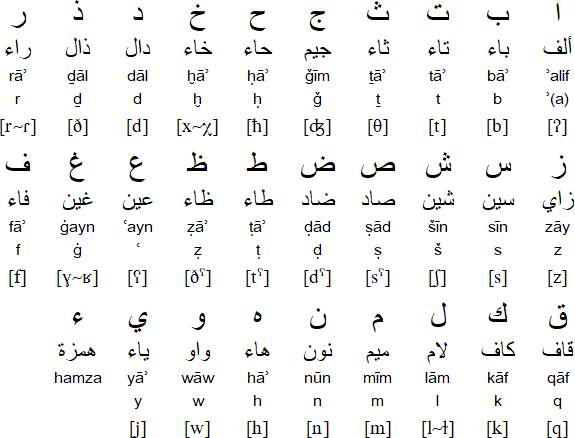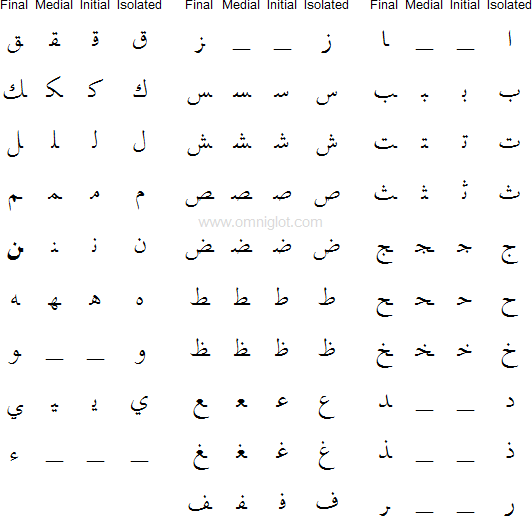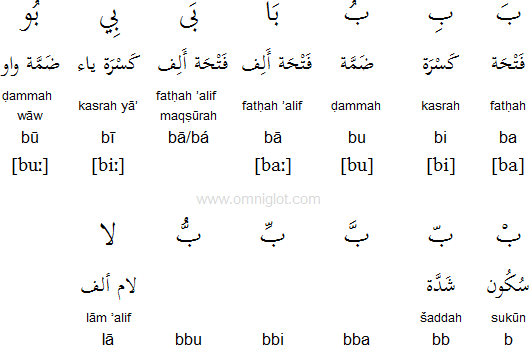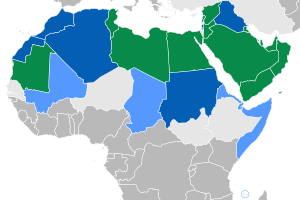Lesson 1 - Part B
Arabic alphabet
Arabic
"The Arabic alphabet (Arabic: الأَبْجَدِيَّة العَرَبِيَّة al-abjadīyah al-ʻarabīyah or الحُرُوف العَرَبِيَّة al-ḥurūf al-ʻarabīyah) or Arabic abjad is the Arabic script as it is codified for writing the Arabic language. It is written from right to left, in a cursive style, and includes 28 letters. Because letters usually[1] stand for consonants, it is classified as an abjad" [2]."The Arabic script evolved from the Nabataean Aramaic script. It has been used since the 4th century AD, but the earliest document, an inscription in Arabic, Syriac and Greek, dates from 512 AD. The Aramaic language has fewer consonants than Arabic, so during the 7th century new Arabic letters were created by adding dots to existing letters in order to avoid ambiguities. Further diacritics indicating short vowels were introduced, but are only generally used to ensure the Qur'an was read aloud without mistakes.
- Modern Standard Arabic (اللغة العربية الفصحى / al-luġatu l-ʿarabiyyatu l-fuṣḥā) - the universal language of the Arabic-speaking world which is understood by all Arabic speakers. It is the language of the vast majority of written material and of formal TV shows, lectures, etc"[1].
Notable Features [1]
- Type of writing system: abjad
- Direction of writing: words are written in horizontal lines from right to left, numerals are written from left to right
- Number of letters: 28 (in Arabic) - some additional letters are used in Arabic when writing placenames or foreign words containing sounds which do not occur in Standard Arabic, such as /p/ or /g/. Additional letters are used when writing other languages.
- Used to write: Arabic, Arabic (Algerian), Arabic (Egyptian), Arabic (Lebanese), Arabic (Modern Standard), Arabic (Moroccan), Arabic (Syrian), Äynu, Azeri, Baluchi, Beja, Bosnian, Brahui, Chechen, Crimean Tatar, Dari, Gilaki, Hausa, Kabyle, Karakalpak, Konkani, Kashmiri, Kazakh, Khowar, Kurdish, Kyrgyz, Malay, Marwari, Mandekan, Mazandarani, Morisco, Pashto, Persian/Farsi, Punjabi, Rajasthani, Salar, Saraiki, Shabaki, Shughni, Sindhi, Somali, Tatar, Tausūg, Turkish, Urdu, Uyghur, Uzbek, Wakhi and a number of other languages
- Most letters change form depending on whether they appear at the beginning, middle or end of a word, or on their own. (see below)
- Letters that can be joined are always joined in both hand-written and printed Arabic. The only exceptions to this rule are crossword puzzles and signs in which the script is written vertically.
- The long vowels /a:/, /i:/ and /u:/ are represented by the letters 'alif, yā' and wāw respectively.
- Vowel diacritics, which are used to mark short vowels, and other special symbols appear only in the Qur'an. They are also used, though with less consistency, in other religious texts, in classical poetry, in books for children and foreign learners, and occasionally in complex texts to avoid ambiguity. Sometimes the diacritics are used for decorative purposes in book titles, letterheads, nameplates, etc.
- Languages written with the Arabic script Arabic (Algerian), Arabic (Egyptian), Arabic (Lebanese), Arabic (Modern Standard), Arabic (Moroccan), Arabic (Syrian), Äynu, Azeri, Baluchi, Beja, Bosnian, Brahui, Chechen, Crimean Tatar, Dari, Gilaki, Hausa, Kabyle, Karakalpak, Konkani, Kashmiri, Kazakh, Khowar, Kurdish, Kyrgyz, Malay, Marwari, Mandekan, Mazandarani, Morisco, Pashto, Persian/Farsi, Punjabi, Rajasthani, Salar, Saraiki, Shabaki, Shughni, Sindhi, Somali, Tatar, Tausūg, Turkish, Urdu, Uyghur, Uzbek, Wakhi
Arabic script [1]
Arabic consonants

The transliteration of consonants used above is the ISO version of 1984. There are various other ways of transliterating Arabic.
This chart shows how the letters change in different positions

Arabic vowel diacritics and other symbols [1]

Arabic numerals and numbers [1]
These numerals are those used when writing Arabic and are written from left to right. In Arabic they are known as "Indian numbers" (أرقام هندية arqa-m hindiyyah). The term 'Arabic numerals' is also used to refer to 1, 2, 3, etc.
The Arabic Language [1]
Arabic is a Semitic language with about 221 million speakers in Afghanistan, Algeria, Bahrain, Chad, Cyprus, Djibouti, Egypt, Eritrea, Iran, Iraq, Israel, Jordan, Kenya, Kuwait, Lebanon, Libya, Mali, Mauritania, Morocco, Niger, Oman, Palestinian West Bank & Gaza, Qatar, Saudi Arabia, Somalia, Sudan, Syria, Tajikistan, Tanzania, Tunisia, Turkey, UAE, Uzbekistan and Yemen.There are over 30 different varieties of colloquial Arabic which include:
- Egyptian - spoken by about 50 million people in Egypt and perhaps the most widely understood variety, thanks to the popularity of Egyptian-made films and TV shows
- Algerian - spoken by about 22 million people in Algeria
- Moroccan/Maghrebi - spoken in Morocco by about 19.5 million people
- Sudanese - spoken in Sudan by about 19 million people
- Saidi - spoken by about 19 million people in Egypt
- North Levantine - spoken in Lebanon and Syria by about 15 million people
- Mesopotamian - spoken by about 14 million people in Iraq, Iran and Syria
- Najdi - spoken in Saudi Arabia, Iraq, Jordan and Syria by about 10 million people
Sample Arabic text (unvocalised) [1]

Sample Arabic text (vocalised) [1]

Transliteration
Yūladu jamī'u n-nāsi aḥrāran mutasāwīna fī l-karāmati wa-l-ḥuqūq. Wa-qad wuhibū 'aqlan wa-ḍamīran wa-'alayhim an yu'āmila ba'ḍuhum ba'ḍan bi-rūḥi l-ikhā'.Listen to a recording of this text by زين العابدين شبيب (Zein Al-A'bideen Shabeeb)
Translation [1]
All human beings are born free and equal in dignity and rights. They are endowed with reason and conscience and should act towards one another in a spirit of brotherhood.(Article 1 of the Universal Declaration of Human Rights).
sources: [1] [2] [3]







